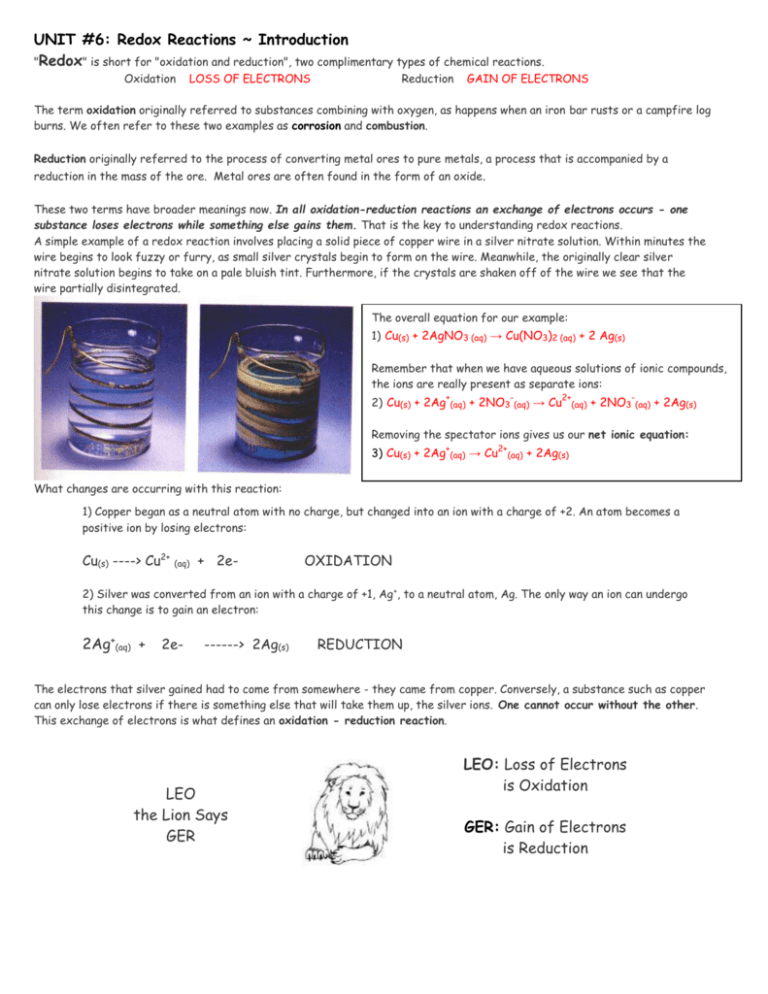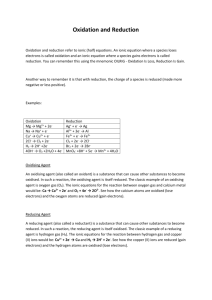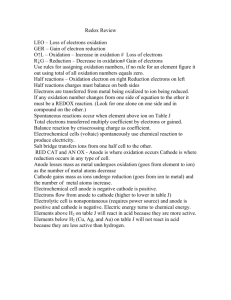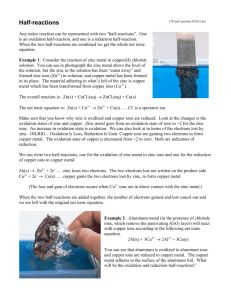Redox Reactions Intro Notes 1
advertisement

UNIT #6: Redox Reactions ~ Introduction "Redox" is short for "oxidation and reduction", two complimentary types of chemical reactions. Oxidation LOSS OF ELECTRONS Reduction GAIN OF ELECTRONS The term oxidation originally referred to substances combining with oxygen, as happens when an iron bar rusts or a campfire log burns. We often refer to these two examples as corrosion and combustion. Reduction originally referred to the process of converting metal ores to pure metals, a process that is accompanied by a reduction in the mass of the ore. Metal ores are often found in the form of an oxide. These two terms have broader meanings now. In all oxidation-reduction reactions an exchange of electrons occurs - one substance loses electrons while something else gains them. That is the key to understanding redox reactions. A simple example of a redox reaction involves placing a solid piece of copper wire in a silver nitrate solution. Within minutes the wire begins to look fuzzy or furry, as small silver crystals begin to form on the wire. Meanwhile, the originally clear silver nitrate solution begins to take on a pale bluish tint. Furthermore, if the crystals are shaken off of the wire we see that the wire partially disintegrated. The overall equation for our example: 1) Cu(s) + 2AgNO3 (aq) → Cu(NO3)2 (aq) + 2 Ag(s) Remember that when we have aqueous solutions of ionic compounds, the ions are really present as separate ions: 2) Cu(s) + 2Ag + (aq) + 2NO3-(aq) → Cu2+(aq) + 2NO3-(aq) + 2Ag(s) Removing the spectator ions gives us our net ionic equation: 3) Cu(s) + 2Ag + (aq) → Cu2+(aq) + 2Ag(s) What changes are occurring with this reaction: 1) Copper began as a neutral atom with no charge, but changed into an ion with a charge of +2. An atom becomes a positive ion by losing electrons: Cu(s) ----> Cu2+ (aq) + 2e- OXIDATION 2) Silver was converted from an ion with a charge of +1, Ag+, to a neutral atom, Ag. The only way an ion can undergo this change is to gain an electron: 2Ag+(aq) + 2e- ------> 2Ag(s) REDUCTION The electrons that silver gained had to come from somewhere - they came from copper. Conversely, a substance such as copper can only lose electrons if there is something else that will take them up, the silver ions. One cannot occur without the other. This exchange of electrons is what defines an oxidation - reduction reaction. LEO the Lion Says GER LEO: Loss of Electrons is Oxidation GER: Gain of Electrons is Reduction QUESTIONS – Refer to the notes on the opposite side of the page to help you answer these. 1) Complete the sentence: In all oxidation-reduction reactions and exchange of __________________________ _____________________________________________________________________________________ 2) What happens during oxidation? ___________________________________________________________ 3) What happens during reduction ? __________________________________________________________ 4) If the oxidation of copper can be written as: Cu(s) → Cu2+(aq) + 2e- write the equation for the oxidation of aluminum: 5) If the reduction of silver can be written as: Ag+(aq) + e- → Ag(s) write the equation for the reduction of gold (III): 6) Identify the following half -reactions as oxidation by writing “O” or reduction by writing “R”. (NOTE: They are called “half-reactions” since they don’t show both oxidation and reduction) a) 2 Br - → Br2 + 2e- _______ b) I2 + 2e- → 2 I- _______ c) Mg → Mg+2 + 2e- ______ d) Fe2+ → Fe3+ + e- ______ 7) If aluminum undergoes oxidation, does it gain or lose electrons? ___________ 8) If bromine undergoes reduction, does it gain or lose electrons? ___________ 9) If Zn changes to Zn2+, was it oxidized or reduced? _______ Did it gain or lose electrons? ________ How many electrons were involved? ________ 10) If O changes to O2-, was it oxidized or reduced? _______ Did it gain or lose electrons? ________ How many electrons were involved? ________ 11) Write the balanced half-reactions for each of the following, use question 8 as a guide: a) oxidation of Mn to form Mn+: _______________________________________________________________________ b) reduction of Cl to form Cl-: __________________________________________________________________________ 12) Fill-in the correct number of missing electrons for each of the following oxidation and reduction half-reactions and make sure you put the electrons on the correct side of the reaction, use question 8 and 13 as a guide: a) 2 H+ d) Na → → H2 Na+ b) Cu → Cu2+ c) O2 → 2 O2- 13) The loss of electrons is called ____________________________ 14) The gain of electrons is called ___________________________ 15) Referring back to the first part of the notes, why do you think a gain of electrons is called reduction?







